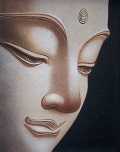- This topic has 7 replies, 2 voices, and was last updated 6 years ago by
Lal.
-
AuthorPosts
-
-
February 6, 2019 at 7:54 am #21819
Tobias G
ParticipantPlease see the post manomaya kaya and the physical body, #3
abhidhamma/gandhabbaya-manomaya-kaya/manomaya-kaya-gandhabba-and-the-physical-body/
“…This fine body with three kaya (kammaja, cittaja, utuja) is called a gandhabba. Since all three have their origin in the mind, the gandhabba is said to have a manomaya kaya. But soon it will acquire a fine physical body by inhaling aroma (gandha + abbha), thus the name gandhabba. Thus a gandhabba would have all four bodies (kammaja, cittaja, utuja, karaja).”
This “fine physical body by inhaling aroma” is part of the utuja kaya, right? Here it gives the impression this is part of the karaja kaya (physical body).
Does “abbha” mean “inhale”?
-
February 6, 2019 at 8:32 am #21820
Lal
KeymasterThe post is: “Manomaya Kaya (Gandhabba) and the Physical Body”
The “fine physical body by inhaling aroma” is NOT part of the utuja kaya.
It belongs to the fourth kaya, the karaja kaya. It is a fine form of karaja kaya. Our karaja kaya is much more dense.
The utuja kaya is more like an “energy field” surrounding the body. It arises due to cittaja kaya.
– Basically citta arise in our minds and are immediately gone. Part of the javana energy created by cittas are converted to the utuja kaya.
– Brahmas have only those three kaya: kammaja, cittaja, and utuja.
– So, a new human (or animal) gandhabba is “born” at the cuti-patisandhi moment with those three kaya. Then with time, it will get a bit more dense by “inhaling” aroma. Here, “inhaling” does not imply they have noses. It is more like absorption. -
February 6, 2019 at 8:46 am #21821
Tobias G
ParticipantThus we have 2 physical bodies, a dense and a fine one?
But the aroma “inhaled” is utu, right? It comes from “external”.
-
February 6, 2019 at 8:56 am #21822
Lal
KeymasterThey are both called karaja kaya. However, karaja kaya of a gandhabba is MUCH FINER. A normal human cannot see a gandhabba.
When a gandhabba enters a womb, it sheds the fine karaja kaya due to aroma absorption that grew while waiting for a womb. P.S. Of course, the material discarded is too fine to be noticed by anyone; finer than dust that we can see.
A new karaja kaya starts when the gandhabba merges with the zygote in the womb:
“Buddhist Explanations of Conception, Abortion, and Contraception“.P.S.
Tobias asked: “But the aroma “inhaled” is utu, right? It comes from “external”.”No. utu does not mean “external”. It means “due to change”. Utuja kaya arises due to the “transformation” of the cittaja kaya. It is really the energy in the cittas transformed to an “energy field”.
– It is also called the “aura body” or “aura field”. -
February 11, 2019 at 2:52 am #21872
Tobias G
ParticipantWhat is the use of the utuja kaya?
-
February 11, 2019 at 6:07 am #21876
Lal
Keymaster“What is the use of the utuja kaya?”
I am not sure whether the utuja kaya has a “use”. It just arises due to the cittja kaya. As I said, citta arise and fade away quickly. Part of the energy in those cittas are released as an “electromagnetic wave” to use terminology of modern science.
These days, there are machines that can monitor this “aura”. It is an energy field.
– When one dies, this field is turned off and the “dead body” becomes inert like a piece of wood. So, this “aura body” is a sign of life. -
February 11, 2019 at 6:32 am #21877
Tobias G
ParticipantIs aharaja same as karaja kaya?
-
February 11, 2019 at 6:52 am #21878
Lal
KeymasterYes. See, “Āhāra (Food) in Udayavaya Ñāna“.
-
-
AuthorPosts
- You must be logged in to reply to this topic.
